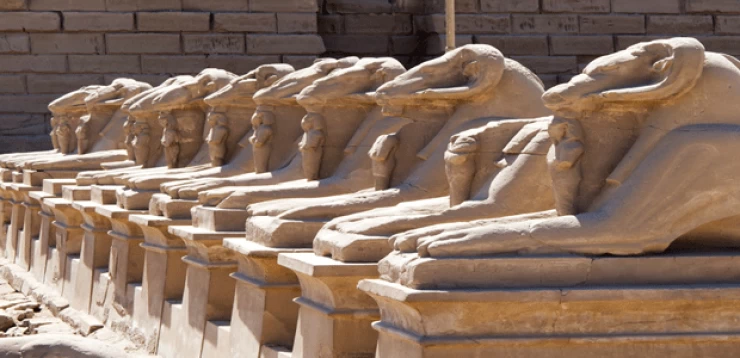
The Twentieth Dynasty in Ancient Egypt
The twentieth Dynasty in Ancient Egypt
King Sakht Nakhti (1190-1187 BC), under the protection of God Amun, put an end to the unrest and turmoil in which the nineteenth dynasty was immersed, establishing the second royal dynasty known as Ramesses. Then, seven other kings, named after Ramses, came after this king.
All the kings of this family carved their graves in the Valley of the Kings in Thebes (although we have not yet identified Ramses VIII cemetery). As for the northern capital, Ramses III, which was frequently visited by King Ramses III, the oldest archaeological remains date back to the era of King Ramses VIII, and the decrease in the water level of the eastern branch of the delta led to the fall of this capital later. In any case, it seems that the latter Ramses preferred to take this northern capital as their headquarters without goodness.
Ramses III (1187 - 1156 BC) Ibn Sitt Nakhti, after assuming the power to save Egypt from attacks by Libyans and invasions of the peoples of the sea, worked in some locations in the Canaanite lands. This king also walked clearly and directly on the approach of Ramses II, but he stressed the impact of moral obligation and the development of the sources of the wealth of God Amin.
But this brilliant brilliance did not continue until the rule of the devout religious King Ramesses IV (1156 - 1150 BC), and after that, a long period of collapse and deterioration prevailed over three-quarters of a century and affected all parts of the Near East with a kind of climate instability, which led to They fall prey to strikes, and the Hebrews and Palestinians fought over the occupation of Palestine, and the Arameans invaded Syria and the Assyrian and Babylonian empires began to suffer from collapse and decay. As for Egypt, which was still imposing its control on Sudan, its influence in Asia has diminished, and it did not put its feet in the Sinai after the death of Ramesses VI. Aspects of activities in the construction of temples were weakened, and the titles of the Ramesses kings were engraved over the empty spaces already present in the pre-existing decorations.
Some of the finest statues of Ramses VI and IX were carved. Finally, during the reign of Ramesses XI, work resumed at the Khonsu Temple at Karnak. Fortunately, the papyri and the cultures found in Deir el-Medina, where the workers in charge of carving and ornamenting the royal tombs, and finding the good files relating to many judicial investigations and texts left by the senior priests of Amen at Karnak have shown us all of those sources the conditions that prevailed in The period in which the political will and the ritual role of the king appeared vaguely is not clear in the south.
Other than the decisions and initiatives of the high priests in Thebes. Since the beginning of Ramesses III's rule, some living difficulties (such as strikes) and disturbances that disrupted public order (such as those plotted in the royal court and some military coups) have emerged, and finally, the Libyans were able to invade the north and create anxiety in the south. It is reported that these Libyans were descended from a POW descendant and then turned into soldiers, or were new leaders who rushed to flee the deserts because of the famines.
Latest Articles
Admin
Seabourn Sojourn Cruise Stops in Safaga Port
The Seabourn Sojourn, the flagship vessel of Seabourn Cruise Line's ultra-luxury fleet, was built in 2008 at the T. Mariotti shipyard in Genoa, Italy. Measuring 198 metres, it can accommodate up to 450 guests in its 225 spacious all-suite staterooms.
Admin
Norwegian Sky Cruise Stops in Safaga Port
Norwegian Cruise Line operates a cruise ship called the Norwegian Sky. It was constructed in 1999 and can accommodate 2,004 passengers in addition to 878 crew members. The ship has several dining establishments, lounges and bars, a spa and fitness center, swimming pools, and a number of entertainment areas.
Admin
Explora II Cruise Stops in Safaga Port
Explora II, the second vessel in the Explora Journeys fleet, sets sail in 2024 to redefine luxury cruising. With 461 ocean-front suites, 9 culinary experiences, and 4 pools, this haven of sophistication and sustainability promises an unforgettable "Ocean State of Mind" journey to inspiring destinations.
Admin
Mein Schiff 6 Cruise Stops in Safaga Port
The Mein Schiff 6 is the latest cruise ship in the renowned TUI Cruises fleet, offering passengers a luxurious and sophisticated cruise experience. At 315 metres long, this floating resort features a range of dining options, entertainment, and recreational facilities, including a spa, fitness centre, and sports amenities.
Admin
Mein Schiff 4 Cruise Stops in Safaga Port
When the Mein Schiff 4 cruise ship docks in Safaga, Egypt, passengers are granted access to a realm of ancient wonders. Aboard this state-of-the-art vessel, guests can embark on meticulously curated shore excursions that showcase the region's most iconic landmarks, including the Giza Pyramids, the enigmatic Sphinx, and the remarkable tombs and temples of the Valley of the Kings in Luxor.
Admin
MS Europa Cruise Stops in Safaga Port
The Silver Moon, Silversea's latest flagship, is a luxury cruise ship that offers an exceptional travel experience for Venezuelans exploring Egypt. With a capacity of 596 guests and an impressive 40,700 gross tonnes, the Silver Moon maintains the small-ship intimacy and spacious all-suite accommodations that are the hallmarks of the Silversea brand.















